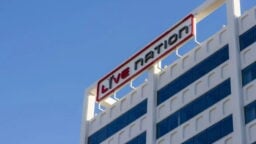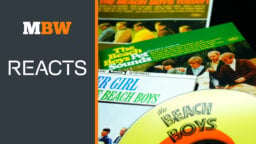In the world of music today, artists have become “direct [to] consumer brands” that build their own audiences, while entertainment and ticketing company Live Nation “delivers the scarcity”.
That’s a key point that Live Nation’s President and CEO, Michael Rapino, made during a presentation at Liberty Media’s annual investor meeting in New York on Thursday (November 9). (Liberty Media owns a 35% stake in Beverly Hills-headquartered Live Nation.).
What does “delivering the scarcity” mean?
It’s Rapino’s way of describing the fact that there is far more demand for tickets to live music events than there is supply. This is how live music has become “the center of the wheel” for artists’ incomes, according to Rapino.
Artists “know live is the part of the machine that keeps everything moving,” Rapino told investors at the Liberty Media event.
“You look at Bad Bunny, he’s at 150 million followers and listeners monthly. We actually only have to sell 3 million tickets, we have the easy part,” Rapino said during an introductory presentation. “In our business, we don’t actually create the demand, the demand gets created and then we sell the demand.”
And that dynamic doesn’t just apply to huge global artists like Bad Bunny, it applies to just about any even moderately successful artist, Rapino asserted.
“You look at an artist playing in the theater right now, they’ve probably got 8 million followers on Instagram… and we’re selling 1,000 tickets,” he said.
Artists today are becoming “media empires” with loyal social media followers who see posts from or about live shows and experience “FOMO” (fear of missing out), driving them to concerts, Rapino said.
That’s one reason why Live Nation expects “incredible growth” in live music in the coming years, delivering double-digit revenue increases in the years to come.
“In our business, we don’t actually create the demand, the demand gets created and then we sell the demand.”
Michael Rapino, Live Nation
Rapino may well have laid out the most compelling argument yet for why live music – despite the growth of the Spotifys of the world – will be the key driver of growth in the music industry going forward.
After all, if there’s one thing missing from the streaming music environment, it’s scarcity.
With digital music workstations and generative AI making it possible for virtually anyone to create recorded music, there are now 120,000 new tracks being uploaded to streaming services every day.
No wonder DSPs like Spotify have been reluctant to raise their subscription rates, even in an era of high inflation. The supply of recorded music – and the availability of numerous streaming services that essentially duplicate each other’s catalogs – means the value of any given piece of recorded music, or a subscription to any one streaming service, isn’t exactly soaring right now.
But in live music, there’s an entirely different dynamic at play.
Five ‘structural shifts’ driving massive growth in live music
Speaking at the Liberty event, Michael Rapino laid out five social, business and technological “structural shifts” emerging across the world that he sees as driving the growth in live music: social media, streaming, music globalization, the “experience economy” and venue infrastructure.
Social media is “the gift that keeps [on] giving to live entertainment,” Rapino said. “You think about social media – TikTok, Instagram – every day amplifying that live show, those FOMO moments that everyone has… [Artists are] connecting with their fans… direct like they’ve never been able to before,” Rapino said.
Thanks to social media, an artist “knows they have 100 million followers. They know where they are. They never knew that for many years. The gatekeepers knew that. So we sit with an artist now and they say, ‘Michael, I’ve got 21 million followers in Brazil, I’ve gotta play Brazil too, and I’ve gotta play Latin America and I’ve got to play Milan.”

Meanwhile, streaming has “made it accessible for every consumer in the world to listen to that song,” Rapino noted.
The globalization of the music business – or perhaps rather the “glocalization” of music, in which local artists around the world gain access to global audiences through social media and streaming – is a theme Rapino has been talking about for some time.
“We’re… seeing this encouraging new supply strategy where for many years, it was all about US- or UK-based artists that filled the charts and filled the stadium. And most other talent was domestic,” Rapino said on Live Nation’s Q1 2023 earnings call in May.
“It might have been big in Canada, it might have been big in Asia, but it didn’t travel. This is the real breakout year where the world and the consumer are truly global. And now you can see artists coming from Latin America and Korea and becoming global superstars. That didn’t happen for the last 30 years.”
The experience economy isn’t a new phenomenon – business schools were talking about it as far back as the 1990s – but it has taken on a new life in the post-pandemic world. After two years at home, consumers are prioritizing experiences over consumer goods perhaps like never before.
And, as the chart below from Rapino’s presentation shows, live music has led the way in the growth of the experience economy, far surpassing sports, recreation, and movie theaters in terms of consumer spending over the past two decades.

Finally, there is venue infrastructure – a key priority for Live Nation, which has been buying and building venues via its Venue Nation division at a breathtaking pace in recent years.
The construction of new venues at every scale – clubs, theaters, arenas – is a key driver behind the trend of major artists touring globally, Rapino said.
Outside of the US, which is well-served by venues of every size, “there’s a whole movement now, if you’re a major city, to figure out how to build venues so live performances can come there,” Rapino said.
“Typically they have soccer stadiums, they don’t have arenas, they don’t have a 5,000-seat [venue], [it’s] been underdeveloped and underserviced [in] most of the world… And every day there’s a new arena built in Sao Paulo or Milan.” And when a new venue goes up, “an artist wants to play there.”
Unlike with streaming, the economics of live music are the same worldwide
Some music industry observers have questioned Live Nation’s global expansion, noting that emerging markets consumers have less money to spend on entertainment.
So one particularly revelatory moment in Rapino’s presentation came when he put up the following slide, showing the gross take of live music around the world compared to the US, next to the gross take for Spotify and Netflix:

Unlike with streaming services, live music consumers in emerging markets are willing – and thanks to rapid growth of their middle class, increasingly able – to pay the same for concerts as consumers in developed markets.
Contrast this with Spotify, which charges 119 rupees per month for an individual subscription in India – the equivalent of USD $1.43.
“That concert ticket truly is a global currency,” Rapino said.
“So when we put Coldplay in Detroit, we’ll be able to charge the same or even more in the Pacific Rim, Eastern Europe or Latin America. This is the reason why these artists now tour globally and the demand’s growing.
“For many years you couldn’t get that same ticket price and you couldn’t make the same amount of money, so you played an extra night in Detroit. Now the pie has grown, that artist looks at us and says ‘I want to get everywhere.’”
Concerts have a price advantage over other live events
Rapino has argued for some time that concert tickets are “dramatically underpriced,” and even as Live Nation takes steps to address that – for instance, through dynamic pricing – Rapino asserted that this price advantage over other live events is one of the elements that makes the concert business relatively resilient in economic downturns.

“This is an industry that has proven time after time [to be] very durable. It does become one of the last things that people do pull back on [in recessions], so as they’re pulling back, this is one of those ones that’s still the most affordable moment.”
Noting that 65% of tickets Live Nation sells in the US are under $100, Rapino said: “You certainly can’t go to a Braves game for that and sit at the dugout. [Liberty Media owns the Atlanta Braves.] God bless sports, it’s a badge of honor to pay $25,000 to be courtside at a Knicks game. But goddamn you if you charge $400 for a Beyonce ticket that happens once every four years.”
Referring to the controversies surrounding the dynamic pricing mechanism that sometimes results in concert tickets selling for multiple thousands of dollars, Rapino said: “We have a pricing PR problem, not a natural problem.”
Tickets are underpriced – but are they also overpriced?
Rapino says the ticketing industry is still figuring out the right price points for concerts – and there may yet be room for higher ticket prices going forward. As evidence of this, he presented statistics showing that prices on the secondary market (resellers and scalpers) have been growing faster than prices on the primary market.

However, during a presentation at the Liberty event, Live Nation President and CFO Joe Berchtold noted that, despite the booming secondary market, fewer than 5% of Live Nation’s shows sell out, and there are 35 million tickets annually that don’t sell, amounting to 20% of Live Nation’s inventory.
“It’s our job as the promoter to figure out, how do we help that artist sell all these tickets? Do we have the right promotions? Do we have the right marketing? What do we need to do to continue to be more effective at selling these tickets?” Berchtold said during the Liberty investor call.
Allow us to present one answer to this question: If the growth in the secondary ticketing market is a sign that tickets could be sold for more, then the unsold inventory of tickets is a sign that for some shows, some tickets could be sold for less.
In other words, it may be that the entire price range for concert tickets is too narrow.
“That concert ticket truly is a global currency.”
Michael Rapino, Live Nation
As Live Nation itself has noted, higher prices for tickets at the front of the house can be used to subsidize lower prices at the back of the house.
There are, of course, some problems with lowering ticket prices, not least being that artists themselves decide the base price of their concert tickets. And yet, lower ticket prices could still be a win for Live Nation and artists, because – as Berchtold noted during the Liberty event – concertgoers that walk through the door are an opportunity for further monetization.
The point of lower-priced tickets “is frankly getting the fans in the building, and getting that average $40 in revenue on top of the ticket price that you’re getting,” Berchtold noted.
Not to mention that – in the wake of all the consumer complaints about rising ticket prices – the arrival of surprisingly cheap concert tickets might just be a rare PR win for Live Nation.






